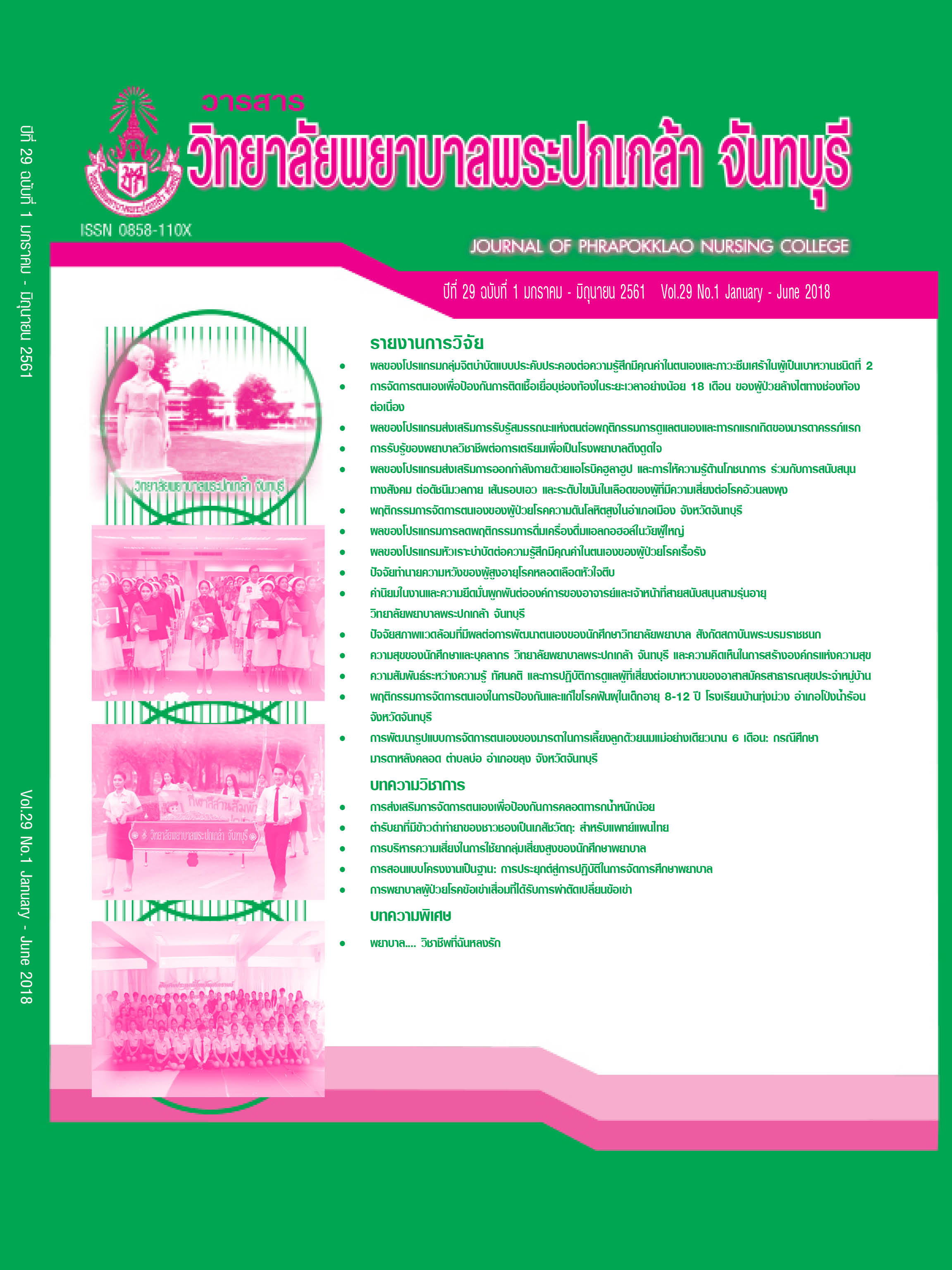Self-management for Preventing Peritonitis at Least 18 Months in Patients with Continuous Ambulatory Peritoneal Dialysis (CAPD)
Keywords:
Chronic kidney disease, Continuous ambulatory peritoneal dialysis, PeritonitisAbstract
This qualitative descriptive research was designed to explore self-management forpreventing peritonitis at least 18 months in patients with continuous ambulatory peritoneal dialysis (CAPD). Participants were 10 chronic kidney disease patients who have had CAPD without peritonitis at least 18 months. All participants have received treatment from Prapokklao Hospital, Chanthaburi Province. Research tools consisted of the researchers, an interview guide of demographic data, an interview guide of self-management for preventing peritonitis in patients with CAPD, and a recorder. Data were collected by in-depth interview technique from January to May, 2016. Data were analyzed using frequency, percentage, mean, standard deviation, and thematic analysis.
The research results found that all participants had good individual self-management for continuous ambulatory peritoneal dialysis. These participants intended to continuously implement peritoneal dialysis procedure based on the suggestions of health care teams in terms of preparing equipment before doing peritoneal dialysis, accurately doing the procedure of peritoneal dialysis, and avoiding half-cooked food. In addition, family-management was key another factor. All participants receive family support to set up proper general environment and peritoneal dialysis room as well as prepare clean equipment for dialysis. All factors accounted for the success of self-management and the disappearance of the peritonitis for at least 18 months among patients with CAPD in this research.
This research suggested that health care providers should use this research results to develop a quality plan to prevent peritonitis for patients with CAPD in any CKD clinic. In addition, researchers should develop a questionnaire of self-management for preventing peritonitis in CAPD patients by using this research results to create items.
References
กิตติมา จันทร์โอ, และสุธิดา โตพันธานนท์. (2551). การพยาบาลผู้ป่วยล้างไตทางช่องท้องปกติที่มีภาวะเยื่อบุช่องท้องอักเสบ. ใน สมชาย เอี่ยมอ่อง, และคณะ. (บ.ก.). Textbook of peritoneal dialysis. หน้า 307-309. กรุงเทพฯ: เท็กซ์ แอนด์ เจอร์นัล พับลิเคชั่น.
คณะแพทยศาสตร์ จุฬาลงกรณ์มหาวิทยาลัย. (2553). คู่มือแนะนำการล้างไตทางช่องท้องอย่างถาวร (พิมพ์ครั้งที่ 2). กรุงเทพฯ: ศิริวัฒนาอินเตอร์ปริ้น. สืบค้น 24 เมษายน 2560, จาก http://www.phraehospital.go.th/library/dublin.php?ID=5265
พนิดา เทียมจรรยา, ชมนาด วรรณพรศิริ, และดวงพร หุ่นตระกูล. (2554). การดูแลตนเองของผู้ป่วยที่มีการติดเชื้อของเยื่อบุช่องท้องจากการรักษาด้วยการล้างไตทางช่องท้องอย่างต่อเนื่อง. วารสารการพยาบาลและสุขภาพ, 5(3), 92-103.
ศิริลักษณ์ อนันต์ณัฐศิริ. (2549). การติดเชื้อในผู้ป่วยที่ได้รับการล้างไตทางช่องท้องชนิดถาวร. ใน ทวี ศิริวงศ์. (บ.ก.). การล้างไตทางช่องท้องสองฝั่งโขง. หน้า 73-81. ขอนแก่น: โรงพิมพ์มหาวิทยาลัยขอนแก่น.
สำนักงานหลักประกันสุขภาพแห่งชาติ. (2556). คู่มือบริหารกองทุนหลักประกันสุขภาพแห่งชาติ ปีงบประมาณ 2556: การบริหารงบบริการผู้ป่วยไตวายเรื้อรัง. กรุงเทพฯ: ผู้แต่ง.
Braun, V., & Clarke, V. (2006). Using thematic analysis in psychology. Qualitative Research in Psychology, 3(2), 77-101.
Creer, L. T. (2000). Self-management of chronic illness. In Boekaerts, M., Pintrich, P. R., & Zeidner, M. (Eds.). Handbook of self-regulationI. pp. 601-629. San Diego, CA: Academic Press.
Grey, M., Knafl, K., & McCorkle, R. (2006). A framework for the study of self- and family management of chronic conditions. Nursing Outlook, 54(5), 278-286.
Grey, M., Schulman-Green, D., Knafl, K., & Reynolds, N. R. (2015). A revised self- and family management framework. Nursing Outlook, 63(2), 162-170. Retrieved April 24, 2017, from https://www.ncbi.nlm.nih.gov/pubmed/25771190
Li, P. K., et al. (2010). ISPD Guidelines/Recommendations: Peritoneal dialysis-related infections recommendations: 2010 update. Peritoneal Dialysis International, 30, 393-423.
Polfuss, M., Babler, E., Bush, L. L., & Sawin, K. (2015). Family perspective of components of a diabetes transition program. Journal of Pediatric Nursing, 30(5), 748-756.
Praditpornsilpa, K. (2011). Report of Thailand replacement therapy year 2011. Bangkok: Thai Nephrology Society of Thailand.
Ryan, P., & Sawin, K. J. (2009). The Individual and Family Self-management Theory: Background and perspectives on context, process, and outcomes. Nursing Outlook, 57(4), 217-225. Retrieved April 24, 2017, from https://www.ncbi.nlm.nih.gov/pmc/articles/PMC2908991/
Sarian, M., Brault, D., & Perreault, N. (2012). Self-management support for peritoneal dialysis patients. Canadian Association of Nephrology Nurses and Technologists, 22(3), 18-24.
Su, C. Y., Lu, X. H., Chen, W., & Wang, T. (2009). Promoting self-management improves the health status of patients having peritoeal dialysis. Journal of Advanced Nursing, 65(7), 1381-1389.
Varitsakul, R., Sindhu, S., Sriyuktasuth, A., Viwatwongkasem, C., & Dennison Himmelfarb, C. R. (2013). The relationships between clinical, socio-demographic and selt-management: Factors and complications in Thai peritoneal dialysis patients. Renal Society of Australasia Journal, 9(2), 85-92.
Downloads
Published
How to Cite
Issue
Section
License
Copyright (c) 2018 Journal of Phrapokklao Nursing College

This work is licensed under a Creative Commons Attribution-NonCommercial-NoDerivatives 4.0 International License.
เนื้อความ ข้อมูล และรายการอ้างอิงที่ผู้เขียนใช้ในการเขียนบทความเพื่อลงตีพิมพ์ในวารสารวิทยาลัยพยาบาลพระปกเกล้า จันทบุรี ถือเป็นความคิดเห็นและความรับผิดชอบของผู้เขียน คณะผู้จัดทำวารสารไม่จำเป็นต้องเห็นพ้องด้วยหรือร่วมรับผิดชอบ
บทความที่ได้รับการลงตีพิมพ์ในวารสารวิทยาลัยพยาบาลพระปกเกล้า จันทบุรี ถือเป็นลิขสิทธิ์ของวารสารวิทยาลัยพยาบาลพระปกเกล้า จันทบุรี หากหน่วยงานหรือบุคคลใดต้องการนำส่วนหนึ่งหรือทั้งหมดของบทความไปเผยแพร่ต่อเพื่อวัตถุประสงค์ใด ๆ จะต้องได้รับอนุญาตจากบรรณาธิการวารสารก่อน



